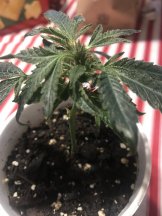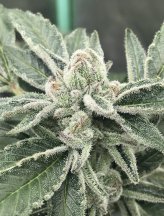HOPS LATENT VIROID (HpLVd)
- Thread starter Opie1
- Start date
bk-og
Moose cocks, or bust
Local guy ordered a few high priced cuts from the states, one had the virus and it spread to his whole garden. He had to cull everything, including some genetics he’s had for years.Anyone have any information or has anyone experienced this disease?
We trade genetics always, but thank god I never had any space in my nursery or I would’ve gotten it too.
I’ll try and find pics of the plants he sent me
bk-og
Moose cocks, or bust
Big time. Thank god a few close friends all have the genetics he had still in their rooms.^That really sucks.
I believe it was the lumpys fritter that he got it from. Can’t remember where he got the cuts from, but I know he paid like $1k for 3 diffent strains.
bk-og
Moose cocks, or bust
Yup. I’ll never not use a new scalpel again in my life because of this.^^^^^ that’s crazy! main reason I use new razors for every plant.
I’ve always just went to town in my veg room with the same scissors on all my plants. Made me reconsider my whole approach at things now after how many years
GreenGrower
Member
Spooky and why I like seeds lol
NoWaistedSpace
PICK YOUR OWN
Will grow fine , then a branch to 1/2 the plant will wilt and die. That shit can spread into the seed. Culturing is about the only option.
Here is a video that explains it pretty good.
Here is a video that explains it pretty good.
Opie1
Master Grower
Back a few weeks ago I had a few seed plants and a cut (my favorite of all time) that just didn’t look right when they started flowering. I’ve flowered the cut many times and it’s never looked like it did this time. I thought (and it still might be) it was due to the temps being a lot cooler, so I never thought a whole lot about it. Not until the two cuttings I took off said cut have failed to do much of anything then I started asking questions.
Here’s a pic of a clone that was put in the cup on Dec 22nd-

It’s grown out new leaves, but no new shoots/limbs, this pic was taken today. And it has good roots.
Here’s a pic of a clone that was put in the cup on Dec 22nd-

It’s grown out new leaves, but no new shoots/limbs, this pic was taken today. And it has good roots.
Opie1
Master Grower
So I’m stumped as to what exactly is going on. If it’s Hops Latent, where’d I get it? I was talking to Heisen about it and he said that a certain percentage of seeds from an infected plant can pass it on. But you’d have to be taking cuts or pruning a plant with infected tools from a carrier plant.
Streetpro09
Tester
Idk man. Definitely a bummer on that comparison picture. I have no advice other than I'm going to keep my fingers crossed that it's just the cold and maybe some root issues this run? 

ttystikk
Nerd Gone Vertical
@Opie1 Sometimes they stall if they aren't warm enough. Stick her someplace with bright light and 85F temps and I bet she'll perk right up.Idk man. Definitely a bummer on that comparison picture. I have no advice other than I'm going to keep my fingers crossed that it's just the cold and maybe some root issues this run?
Opie1
Master Grower
Oh I’ve had the clones in the house and even set them in direct sunlight daily and then back under a light at dark. You’d think after 6+ weeks they’d be doing more. They were taken at probably 3-4 weeks into flower, so it usually takes a little longer but not this long.@Opie1 Sometimes they stall if they aren't warm enough. Stick her someplace with bright light and 85F temps and I bet she'll perk right up.
PuffTheMagic
Super Active Member
Based on the semi-limited research I've done on hplvd, it seems mostly an issue with extremely inbreed genetics where the breeders have inadvertently selected out most of the plants natural defenses.
As the name suggests, Hop Latent Viroid (HpLVd) was first identified in hops. Ironically, infected hop plants are asymptomatic. In contrast, infected hemp plants (Cannabis sativa) may or may not manifest any apparent symptoms. Symptoms include stunted growth, reduced vigor, brittle stems with less flower mass and stunted trichomes. This disease is commonly known as dudding.
Viroids are the smallest known pathogens of row crops and fruit trees. Like some plant pathogenic viruses, viroids are single-stranded RNA molecules; however, viroids are smaller in size and are not encapsidated. Potato spindle tuber viroid was the first viroid that was discovered in 1971. To date, twenty-nine more viroids have been discovered and characterized.
Studies indicate that the HpLVd is mainly introduced by infected propagation material. Subsequent viroid transmission from infected to healthy plants is shown to be through horticultural practices. Such mode of transmission (mechanical transmission) is also very common in phytopathogenic viral species. In hops, transmission of HpLVd was shown to be more effective with tools (e.g. pruning shears) rather than natural abrasions caused by physical contact of individual plants. In addition, no evidence of transmission and long-distance spread of the viroid by aphids has been established.
Viroids are the smallest known pathogens of row crops and fruit trees. Like some plant pathogenic viruses, viroids are single-stranded RNA molecules; however, viroids are smaller in size and are not encapsidated. Potato spindle tuber viroid was the first viroid that was discovered in 1971. To date, twenty-nine more viroids have been discovered and characterized.
Studies indicate that the HpLVd is mainly introduced by infected propagation material. Subsequent viroid transmission from infected to healthy plants is shown to be through horticultural practices. Such mode of transmission (mechanical transmission) is also very common in phytopathogenic viral species. In hops, transmission of HpLVd was shown to be more effective with tools (e.g. pruning shears) rather than natural abrasions caused by physical contact of individual plants. In addition, no evidence of transmission and long-distance spread of the viroid by aphids has been established.


